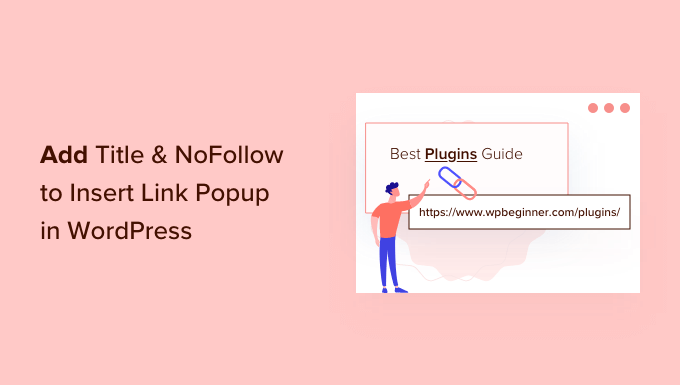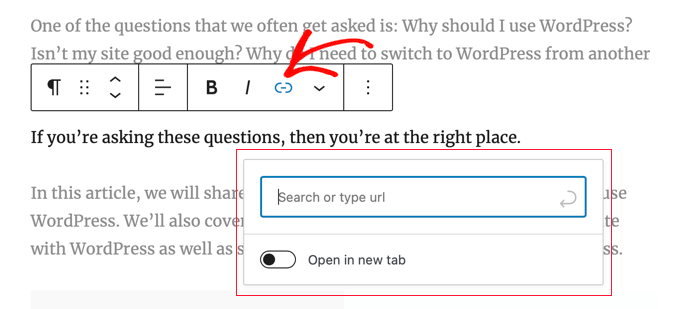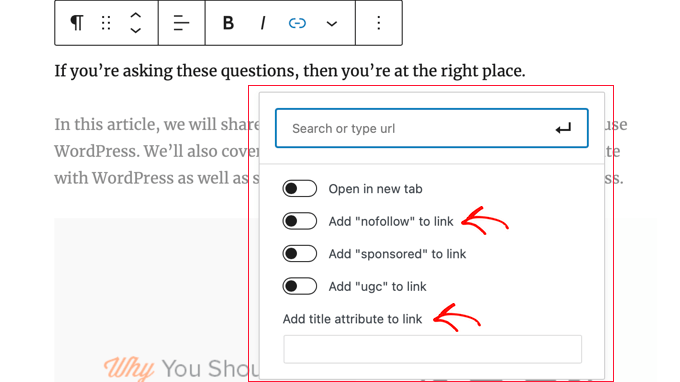Want to know a couple of simple tweaks we make at WPBeginner to seriously improve our links? We’re talking about things that boost both user experience and SEO. We add a title attribute to every link and use the nofollow tag on many external links.
The title attribute might seem small, but it makes a real difference. It gives visitors a little preview of where a link will take them before they even click. And nofollow tells search engines what’s important on our site and how we want to share (or not share) link authority.
But here’s the thing we’ve bumped into – WordPress by itself doesn’t make it easy to add either of these. Kind of frustrating, right?
This article provides a simple guide on how to add options for title and nofollow attributes to the Insert Link popup in WordPress, streamlining your workflow and boosting your SEO efforts.

Why Add Title and NoFollow Attributes to Links in WordPress?
When you’re writing content, you naturally add links, right? It’s how you connect your own posts and pages and point to other helpful resources out there. We do it all the time!
These links guide people around and give them extra info. But just a link isn’t always enough. That’s why we like to give our links a title. You know, that little bit of text that pops up when you hover your mouse over a link?
We’ve found that adding a title is actually super helpful for readers. It’s like giving them a little preview or a hint about where they’re going if they click.
‘Oh, that link goes to an article about creating free business email addresses,’ they might think when they see the title. It just makes things clearer and more reassuring for them.

Plus, and this is a nice bonus, it can give your SEO a little nudge too. Search engines seem to like that extra context.
Now, let’s talk about nofollow. This is something we use a lot, especially when we’re linking to other websites.
Basically, the nofollow attribute is a way to tell search engines, ‘Hey, you can follow this link, but don’t pass on any link authority to that other site from our site.’ It sounds a bit technical, but it’s actually pretty straightforward once you get the hang of it.
SEO experts often recommend using a nofollow attribute for external links, and we tend to agree with that for certain situations. It’s not about being unfriendly! It’s more about managing how link authority flows on the web and focusing on what’s most important for our SEO.
For example, if we’re linking to a site that we don’t fully endorse or if it’s a sponsored link, nofollow is definitely our go-to.
But here’s the annoying part. When you’re in WordPress and you click that ‘Insert Link’ button, you’ll notice there are no options for adding a link title or making a link nofollow! Seriously? All you get is the Link URL field and a checkbox for opening in a new window.

It’s kind of basic and, honestly, not very helpful for anyone who cares about SEO or user experience. We definitely think WordPress could improve this!
With that being said, let’s take a look at how to easily add title and nofollow options to the Insert Link popup on your WordPress blog.
How to Add Title and NoFollow to Insert Link Popup in WordPress
So, how do we fix this? The first thing you need to do is install the free All in One SEO Lite plugin. For more details, see our step-by-step guide on how to install a WordPress plugin.
We’ve been recommending AIOSEO for years – it’s just the best WordPress SEO plugin out there, in our opinion. And you only need the free version to get these extra link options, which is fantastic. Of course, AIOSEO Pro is even more powerful if you’re serious about ranking higher.
Upon activation, you need to configure the plugin using the AIOSEO setup wizard. For detailed instructions, see our ultimate guide on how to set up All in One SEO for WordPress.
Once you’ve done that, the plugin will automatically add extra attributes to the popup that appears when you click the Insert Link button.
These include a title field and options to add nofollow, sponsored, and UGC (user-generated content) tags.

To add the link title, just type it into the ‘Add title attribute to link’ field. When you save the link, AIOSEO will apply the title and any attributes you toggle on.
Expert Guides for Adding Links in WordPress
We hope this tutorial helped you learn how to add title and nofollow options to the Insert Link popup in WordPress. You may also want to see our best guides on how to create, track, and fix links on your WordPress site:
- Beginner’s Guide on How to Add a Link in WordPress
- Internal Linking for SEO: The Ultimate Guide of Best Practices
- Best Internal Linking Plugins for WordPress (Automatic + Manual)
- How to Track Link Clicks and Button Clicks in WordPress (Easy Way)
- How to Find and Fix Broken Links in WordPress (Step by Step)
If you liked this article, then please subscribe to our YouTube Channel for WordPress video tutorials. You can also find us on Twitter and Facebook.





Dennis Muthomi
Quick question….you mentioned that SEO experts recommend using a nofollow attribute to external links.
I have a slightly different approach – the only external links that I add nofollow attributes to are affiliate links. If I’m linking out to a helpful resource like a government site (.gov), or a statistics webpage, I always use a dofollow link.
my thinking is that for truly valuable and authoritative sources, I want to pass on some link juice rather than using a nofollow.
What’s your take on this? Should I just have nofollow on all external links like most SEOs recommend, or does my method of selectively applying nofollow make sense?
WPBeginner Comments
Generally, it’s recommended to set all external links to “nofollow” for safety, and then when you have a high quality resource, you can use “dofollow”. There is no one size fits all, it just depends on your needs.
Dennis Muthomi
thank you for the clarification!
makes sense to me to use nofollow as a default for external links, but allow some dofollow juice to flow to really authoritative sites when it adds value for readers.
appreciate you taking the time to clarify – solid advice as always from the WPBeginner team!
Jiří Vaněk
I would like to ask, within the scope of SEO, if I want only external links to have the nofollow attribute. Leave internal links as they are, but set nofollow indiscriminately for all external links. I want this in order for the robot on my website not to follow external links. How to solve it? Through a snippet of code or a plugin?
WPBeginner Support
We have a guide on how to nofollow external links that you should find helpful below
https://www.wpbeginner.com/plugins/how-to-nofollow-all-external-links-in-wordpress/
Admin
Stuart
Hi there,
It’s worth noting this won’t work in the Gutenberg editor.
Cheers.
WPBeginner Support
We’ll be sure to look into updating this article
Admin
Editorial Staff
The article has been updated to reflect a new solution which works in both Gutenberg as well as classic editor.
Admin
Kulwant
can this plugin slow down over website speed ?
WPBeginner Support
Hi Kulwant,
No, it doesn’t affect site speed.
Admin
Bikramjit
Hi,
I have added link of some research journals, they are like authorities. Should I keep those link as nofollow link.
best regards
Bikramjit
John
I read this article today and installed the plugin, but it hasn’t been updated for the last 2 years?
Is it still a safe and good plugin to use then? Or is there a better one by now?
I have seen quite some nofollow plugins but none that include the Title as well.
Any advice would be nice :).
Great article!
WPBeginner Support
Hi John,
We reached out to the plugin author and they have updated the plugin. You can now safely install it on your website.
Admin
Jasmin
Hi, great tutorial!!! Can you please tell me how you added the hyperlink to the “Editorial Staff” text beneath the title?
Theodore Nwangene
This is really a very awesome tutorial,
I understand how important it is to nofollow our external links especially when its an affiliate link and thats what made this post amazing.
A friend was just asking me the other day how to easily make a link nofollow now, which other way will be easier than what you just explained here?
I’m going to forward this post to him right away and will also download the plugin as soon as possible.
Thanks for sharing.
Viacheslav
Isn’t that simpler to add rel=”nofollow” and title manually when adding the link in the TEXT mode? I usually do this with no bother
WPBeginner Support
Yes you can do that too if you find it more convenient.
Admin
Barry Richardson
Am I assuming correctly that each link on a blog would have to be individually set? After all, we might want to “do-follow” some outbound links and “no-follow” others – or we might want to link to a different post on the same site, which typically should be “do-follow”.
WPBeginner Support
Yes this is why this plugin is helpful. You can leave the nofollow box unchecked if you want to create a dofollow link.
Admin
John D
I’very never understood why WP by default has no title attribute to set in its link dialog. Blogger had it in 2008!
WPBeginner Support
WordPress had it too. It was removed in WordPress 4.2.
Admin
Olivia Smith
Do we have to change HTML setting individually for every blog we post ?
WPBeginner Support
No, unless you want to.
Admin
Connor Rickett
The real question is, Why isn’t this isn’t a default feature in WordPress?
I mean, all it needs is a little checkbox in the link section, follow/nofollow, and, poof, powerful new feature. No muss, no fuss, barely any tears.
Mark Corder
“but you don’t want to pass away any link authority to these websites.” …
What exactly is meant by that?
Atila
It means that you don’t want search engines to pick up that link while crawling. The link is there for reference or for whatever reason, and you are not giving him your PR juice. It would be bad to have a website full of dofollow outbound links, especially if they lead to poor content website. Only leave clean links to sites that you care of and are important.
Gulshan
Please make a list of Perfect plugin to manage all over SEO.